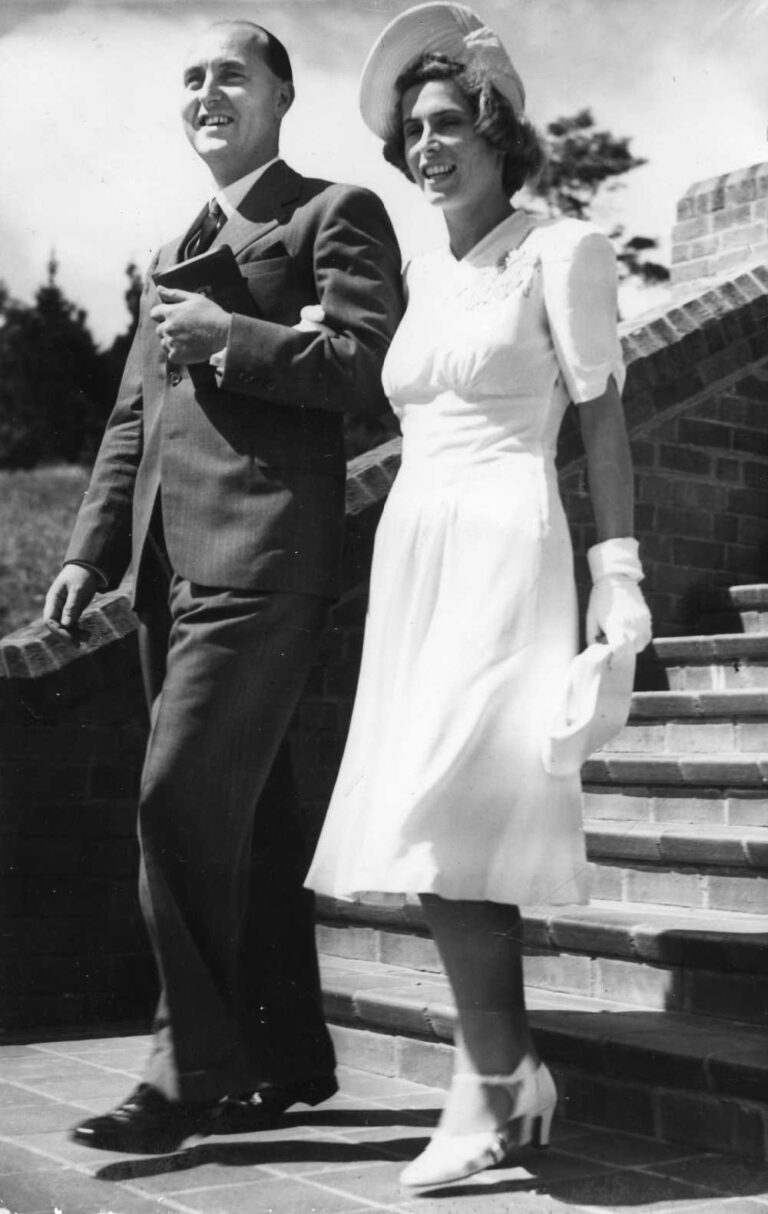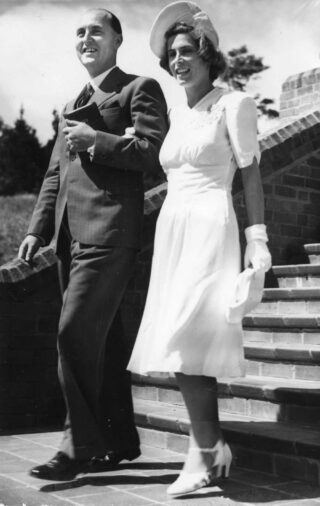- Entry type: Person
- Entry ID: AWE4784
Hewitt, Alison Hope
- Lady Hewitt
Downing, Alison (pen name for the Canberra Times)

- Born 30 October 1915, Sydney, , Australia
- Died 18 March 2011, Canberra, , Australia
- Occupation University lecturer, Writer
Details
Hope Hewitt was born in Sydney on 30 October 1915, the third of four daughters of Robin and Pattie Tillyard. The family lived in New Zealand from 1920 to 1928 before moving to Red Hill, Canberra following Dr Robin Tillyard’s appointment as first head of Council for Scientific and Industrial Research (CSIR) entomology division. With their striking looks and academic and sporting abilities the sisters (Patience, Faith, Hope and Honour) became well-known identities in the new capital city. All played sport; Hope excelled at tennis and hockey. In 1934 she caused some angst for tennis officials by wearing shorts, then a ‘new fashion’.
Hope was an outstanding student at Nelson Girls’ College, New Zealand and at Telopea Park High and St Gabriel’s in Canberra. She won a scholarship to study arts at Sydney University and then fine arts at Sydney Technical College. She graduated Bachelor of Arts with first class honours and Master of Arts. Early in 1937 she was involved in an accident while driving her father from Canberra to Sydney in which Robin Tillyard was killed and Hope seriously injured. In May she and her mother left for England where they spent nine months.
Late in 1938 Hope returned to Europe to study painting in Paris under Jacques Ernotte, a distinguished artist and set designer, but the outbreak of World War II forced her to flee to London leaving behind canvasses selected for showing at the prestigious Salon d’automne. In London she and her older sister Pat drove ambulances before returning to Australia on S.S. Rotorua which carried children evacuated from Britain. During the voyage one of the ships in the convoy was sunk by a torpedo fired from a German U-boat.
In 1942 Hope married public servant, Lenox Hewitt (later knighted) at Scotch College Chapel, Melbourne and accompanied him to London when he was posted to the Australian High Commission. After they returned to Canberra in 1953 she studied at Canberra University College (subsequently part of the Australian National University) graduating Bachelor of Commerce from the parent body, the University of Melbourne. She began teaching in the English department at the College and after holding temporary positions was appointed to the new position of Lecturer in 1958. Under Professor A D Hope she specialised in Elizabethan and Jacobean drama and the 18th and 19th-century English novel, inspiring students with her love of literature and theatre. From 1960 she was a member of the Commonwealth Literature Censorship Board and in 1968 was appointed deputy chair of the National Literature Board of Review which succeeded the Censorship Board.
On sabbatical leave from Australia’s National University (ANU) in 1964, Hope studied with the renowned Shakespearean scholar Lionel Knights in Bristol. Then, and on later visits to London, she attended performances by the Royal Shakespeare Company, the Old Vic and other British theatre troupes and, years later, could recall the productions in astonishing, colourful detail. She was an enthusiastic supporter of Canberra Repertory Theatre attending performances and reviewing their productions for the Canberra Times. She was the first woman appointed to the board of the new Canberra Theatre serving from 1968 to 1976.
At a time when it was unusual for married women to work, she combined a demanding, full-time career with raising four children, supporting her husband’s career and helping to care for her mother, Pattie Tillyard. For many years she contributed theatre reviews, book reviews and poetry to the Canberra Times. In her large and beautiful garden, she raised chickens and grew vegetables and fruit that she cooked, preserved and gave away to friends and good causes. She sewed, knitted and did patchwork and weaving often sitting on winter evenings in front of an open fire knitting a sweater while she marked students’ essays or prepared her next lecture. Hope also served on the council of Garran College at the ANU and contributed to the Canberra community as a hospital volunteer, English teacher to new arrivals, and supporter of several charities.
Like her mother, she was a feminist, believing that women needed to earn their own living and take a lead in their community. She had extraordinary energy and willpower. She enthusiastically supported her children’s multiple activities and was delighted with their varied careers: Patricia as a social activist and cabinet minister in the Blair Labour government in Britain (Secretary of State for Trade and Industry 2001-5 and Health Secretary 2005-7); Antonia (died 1990) as an interpreter with the European Commission in Brussels; Hilary, an architect, one of whose designs was her aunt Pat Wardle’s house in Garran; and Andrew, a captain with Qantas and a farmer near Hall.
Hope Hewitt died at Brindabella Gardens nursing home in Canberra, aged 95.
Archival resources
Digital resources
Published resources
- Newspaper Article
- Magazine
-
Resource
- Trove: Hewitt, Alison Hope (19151030-20110318), http://nla.gov.au/nla.party-1629899
-
Site Exhibition
- From Lady Denman to Katy Gallagher: A Century of Women's Contributions to Canberra, Australian Women's Archives Project, 2013, http://www.womenaustralia.info/exhib/ldkg
